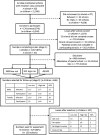The impact of nonverbal ability on prevalence and clinical presentation of language disorder: evidence from a population study
- PMID: 27184709
- PMCID: PMC5082564
- DOI: 10.1111/jcpp.12573
The impact of nonverbal ability on prevalence and clinical presentation of language disorder: evidence from a population study
Abstract
Background: Diagnosis of 'specific' language impairment traditionally required nonverbal IQ to be within normal limits, often resulting in restricted access to clinical services for children with lower NVIQ. Changes to DSM-5 criteria for language disorder removed this NVIQ requirement. This study sought to delineate the impact of varying NVIQ criteria on prevalence, clinical presentation and functional impact of language disorder in the first UK population study of language impairment at school entry.
Methods: A population-based survey design with sample weighting procedures was used to estimate population prevalence. We surveyed state-maintained reception classrooms (n = 161 or 61% of eligible schools) in Surrey, England. From a total population of 12,398 children (ages 4-5 years), 7,267 (59%) were screened. A stratified subsample (n = 529) received comprehensive assessment of language, NVIQ, social, emotional and behavioural problems, and academic attainment.
Results: The total population prevalence estimate of language disorder was 9.92% (95% CI 7.38, 13.20). The prevalence of language disorder of unknown origin was estimated to be 7.58% (95% CI 5.33, 10.66), while the prevalence of language impairment associated with intellectual disability and/or existing medical diagnosis was 2.34% (95% CI 1.40, 3.91). Children with language disorder displayed elevated symptoms of social, emotional and behavioural problems relative to peers, F(1, 466) = 7.88, p = .05, and 88% did not make expected academic progress. There were no differences between those with average and low-average NVIQ scores in severity of language deficit, social, emotional and behavioural problems, or educational attainment. In contrast, children with language impairments associated with known medical diagnosis and/or intellectual disability displayed more severe deficits on multiple measures.
Conclusions: At school entry, approximately two children in every class of 30 pupils will experience language disorder severe enough to hinder academic progress. Access to specialist clinical services should not depend on NVIQ.
Keywords: Developmental language disorder; NVIQ discrepancy; functional impairment; prevalence.
© 2016 The Authors. Journal of Child Psychology and Psychiatry published by John Wiley & Sons Ltd on behalf of Association for Child and Adolescent Mental Health.
Figures


Similar articles
-
Language growth in children with heterogeneous language disorders: a population study.J Child Psychol Psychiatry. 2017 Oct;58(10):1092-1105. doi: 10.1111/jcpp.12793. J Child Psychol Psychiatry. 2017. PMID: 28921543 Free PMC article.
-
Younger children experience lower levels of language competence and academic progress in the first year of school: evidence from a population study.J Child Psychol Psychiatry. 2016 Jan;57(1):65-73. doi: 10.1111/jcpp.12431. Epub 2015 Jun 4. J Child Psychol Psychiatry. 2016. PMID: 26041601 Free PMC article.
-
Auditory processing and neuropsychological profiles of children with functional hearing loss.Int J Pediatr Otorhinolaryngol. 2018 Nov;114:51-60. doi: 10.1016/j.ijporl.2018.07.054. Epub 2018 Jul 31. Int J Pediatr Otorhinolaryngol. 2018. PMID: 30262367
-
Autism, Language Disorder, and Social (Pragmatic) Communication Disorder: DSM-V and Differential Diagnoses.Pediatr Rev. 2015 Aug;36(8):355-62; quiz 363. doi: 10.1542/pir.36-8-355. Pediatr Rev. 2015. PMID: 26232465 Review.
-
Neuropsychological function in Tourette syndrome.Adv Neurol. 2001;85:103-11. Adv Neurol. 2001. PMID: 11530420 Review.
Cited by
-
RECALL prompting hierarchy improves responsiveness for autistic children and children with language delay: a single-case design study.Front Psychol. 2024 Oct 25;15:1435688. doi: 10.3389/fpsyg.2024.1435688. eCollection 2024. Front Psychol. 2024. PMID: 39526124 Free PMC article.
-
The effectiveness of language nursing intervention on mental health in children with poor language skills.PLoS One. 2024 Nov 1;19(11):e0313095. doi: 10.1371/journal.pone.0313095. eCollection 2024. PLoS One. 2024. PMID: 39485766 Free PMC article.
-
Impact of developmental language disorders on mental health and well-being across the lifespan: a qualitative study including the perspectives of UK adults with DLD and Australian speech-language therapists.BMJ Open. 2024 Oct 22;14(10):e087532. doi: 10.1136/bmjopen-2024-087532. BMJ Open. 2024. PMID: 39438095 Free PMC article.
-
Prevalence and heritability of parental-reported speech and/or language difficulties in a Swedish population-based twin sample.JCPP Adv. 2024 Jan 31;4(3):e12221. doi: 10.1002/jcv2.12221. eCollection 2024 Sep. JCPP Adv. 2024. PMID: 39411473 Free PMC article.
-
Word Learning in Bilingual Children at Risk for Developmental Language Disorder.Am J Speech Lang Pathol. 2024 Nov 4;33(6):2746-2766. doi: 10.1044/2024_AJSLP-23-00489. Epub 2024 Oct 7. Am J Speech Lang Pathol. 2024. PMID: 39374488
References
-
- Adams, C. , Cooke, R. , Crutchley, A. , Hesketh, A. , & Reeves, D. (2001). Assessment of comprehension and expression 6‐11. GL assessment. Available from: http://www.gl-assessment.co.uk/products/assessment-comprehension-and-exp... [last accessed 27 April 2016].
-
- American Psychiatric Association (2013). Diagnostic and statistical manual of mental disorders (5th edn). Washington, DC: Author.
-
- Beitchman, J.H. , Nair, R. , Clegg, M. , & Patel, P.G. (1986). Prevalence of speech and language disorders in 5‐year‐old kindergarten children in the Ottawa‐Carleton region. Journal of Speech and Hearing Disorders, 51, 98. - PubMed
-
- Bishop, D.V.M. (2003a). Children's communication checklist‐2. London: Pearson.
-
- Bishop, D.V.M. (2003b). Test for reception of grammar (TROG‐2) (2nd edn). London, UK: Pearson Assessment.
Publication types
MeSH terms
Grants and funding
LinkOut - more resources
Full Text Sources
Other Literature Sources
Medical

